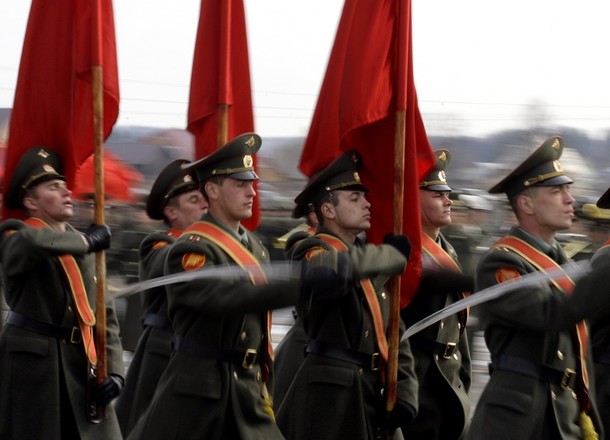
Russia’s Victory Day Parade Masking Decline
Publication: Eurasia Daily Monitor Volume: 6 Issue: 91
By:

The Victory Day military parade in Moscow on May 9, marking the 64th anniversary of the Soviet defeat of Nazi Germany, offered a curious mixture of pomp, myth and nostalgia -all vital elements for the Russian leadership. As the Spassky Tower on Red Square struck 10:00 am, the parade began, overseen by President Dmitry Medvedev and Prime Minister Vladimir Putin from a dais erected in front of Lenin’s mausoleum concealed by a Russian tricolor in an effort to avoid its more obvious Soviet overtones. The display of "military power" which ensued was assiduously calculated to offer a striking visual image against which Medvedev could warn any country considering "military adventurism" against Russia. It also served as a temporary escape from the reality of the crisis within Russia’s armed forces and the deepening economic malaise affecting the country (ITAR-TASS, May 9).
Medvedev avoided any specific reference to the war with Georgia in August 2008, though he alluded to the five-day conflict, saying that the lesson of World War II "remains acute today when again there are those who engage in military adventurism." Moreover, amongst his Victory Day messages of congratulations, Medvedev also included the leaders of Abkhazia and South Ossetia. He referred to personnel taking part in the parade that had, "proven the high capability of the Russian military in real action" (www.kremlin.ru, Interfax, May 9).
The preparations for the parade had been costly and intensive. This involved training the various military units for almost two months in Alabino, 50 kilometers south-west of Moscow which boasts a replica of Red Square. The cost of staging the parade itself was estimated at 205 million rubles ($6.3 million). Local authorities in Moscow confirmed that expenditure had involved repairing paving slabs on Red Square and in the surrounding area, as well as preparing the roads for the arrival of military vehicles. It also paid for city workers to clean a large Soviet symbol -a red and gold star- to be placed above the GUM department store for the occasion (ITAR-TASS, www.russiatoday.ru, May 9).
The Victory Day parade was the largest since the collapse of the Soviet Union, including 9,000 personnel, accompanied by a military orchestra of 1,100 musicians, 110 pieces of heavy equipment and 70 aircraft and helicopters. This was larger than the parade held in May 2008, in which military hardware made its re-appearance on Red Square, the number of personnel increased by 1,000 and the aerial component doubled in size (RIA Novosti, May 9).
Parade commander Colonel-General Valery Gerasimov, chief of the Moscow Military District and Defense Minister Anatoly Serdyukov took the salute from an open-top Zil limousine, observing the passing of Russia’s latest T-90 main battle tanks, armored personnel carriers, howitzers and cannons. The Russian Air Force displayed strategic bombers, transporters, fighter jets, frontal bombers and attack helicopters. The Mi-28 (Havoc) all-weather attack helicopter appeared over Moscow for the first time (www.welt.de, May 9). In an effort to project a positive image of Russian conventional military power, the S-400 (Triumph) air defense system was shown, no doubt partly to boost its profile on the international arms market.
Russia’s nuclear capability was proudly highlighted, repeating last year’s decision to showcase four Topol ICBM launchers. The best crews from the Strategic Rocket Forces (RSVN) were chosen to participate using the four launchers, with mock launch tubes. These were undergoing training for the parade since April (RIA Novosti, April 15).
Yet, inadvertently underscoring the mythical dimension of the display, all the uniforms worn for the event featured the new design originally scheduled for introduction throughout the armed forces, which has since been abandoned owing to the costs involved. Indeed, Serduykov must have been stunned by his commander-in-chief claiming that the Georgia conflict had proven the combat capability of the Russian armed forces. After all, he has consistently argued precisely the opposite: the conflict had revealed major structural flaws and justified a radical reform program.
Indeed, Russia’s experience of the global financial crisis has impacted on several aspects of that much publicized reform plan. Re-locating the Navy headquarters from Moscow to St. Petersburg and introducing new uniforms have proven early casualties in the process, caused by lack of finance. This has also undermined the intention to reduce the officer corps by 2012 with cuts of as many as 200,000 posts, and plans to modernize and re-equip the military -which exposed the decayed condition of the country’s defense industries- leaving the entire process in jeopardy. In March, Serdyukov suggested that as much as 90 percent of Russian military equipment might be obsolete: in stark contrast to the hardware used on Red Square (Interfax, March 21).
Nevertheless, the Russian leadership confronted with economic downturn and seeing NATO as a threat to the country, attempts to re-mould an image of its military power in order to threaten Russia’s "enemies." "I think, the Red Square parade made everyone feel proud for our country," Medvedev told veterans at a Kremlin reception after the parade (Rossiya TV, May 9).
The pattern emerging in relation to these parades, with the reappearance of military hardware on Red Square in 2008 and staging a larger Victory Day parade this year, suggests that the event in 2010 will be held on an even more grand scale -marking the 65th anniversary of the end of World War II. In the meantime, the gap between image and reality is steadily widening, perhaps necessitating the continued emphasis placed on "show." However, few senior Russian military personnel will believe the claims made on May 9 that the country’s conventional military power is capable of adequately meeting the challenges of modern warfare.




